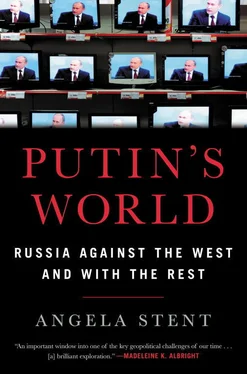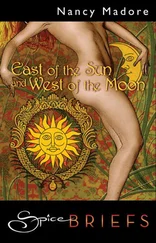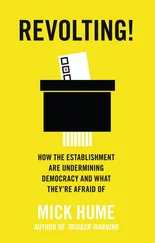At the end of the USSR, acrimonious rhetoric was exchanged between Ukrainian and Russian officials, parliamentarians, and commentators; there was a concern that war—perhaps even a nuclear conflict—might break out. Hence the urgency the West felt to move the nuclear weapons out of Ukraine. The new Ukrainian government, suspicious of Yeltsin’s longer-term intentions, asked the Americans to give it security guarantees similar to those of NATO members—namely that the United States would come to Ukraine’s assistance were it attacked by another power. But American officials realized that was impossible and proposed that Russia also provide Ukraine with security assurances. And so, after an arduous negotiation process, the US insisted on using the word “assurances” instead of “guarantees” in the legal document that accompanied Ukraine’s denuclearization. “Assurance” implies a lesser commitment than “guarantee.” Here is where translation fails. The problem is that both Russian and Ukrainian use the same word for guarantee and assurance, leaving room for misinterpretation.
In January 1994, Bill Clinton had to twist the arms of both Yeltsin and Kravchuk to sign a trilateral agreement on the disposition of Ukraine’s nuclear weapons. 23He met with them in Moscow wearing a button that read “Carpe Diem” (Seize the Day). 24In December of that year, the deed was finalized in Hungary with the new Ukrainian president, Leonid Kuchma. The Budapest Memorandum on Security Assurances was signed by the United States, the United Kingdom, and Russia. The three signatories agreed to “respect the independence and sovereignty and the existing borders of Ukraine,” “to refrain from the threat or use of force against the territorial integrity or political independence of Ukraine,” and “to seek immediate United Nations Security Council action to provide assistance to Ukraine… if Ukraine should become a victim of an act of aggression.” 25
In June 1996, two trains carrying the last strategic nuclear warheads departed Ukraine and arrived in Russia, where the warheads were delivered to a dismantlement facility. Ukraine had given up its nuclear weapons in return for security “assurances” from Russia, the United States, and the United Kingdom. Just how credible these were became clear in March 2014, when neither the United States nor the United Kingdom came to Ukraine’s assistance after Russia’s military incursion into Crimea and later into the Donbas region. Nor was the United Nations able to intervene, because of Russia’s veto in the Security Council. The Budapest Memorandum was a dead letter, a lesson not lost on either advocates of nonproliferation or states aspiring to become nuclear powers. Giving up nuclear weapons makes a country vulnerable to outside aggression.
The Black Sea Fleet was the second most contentious issue between Russia and Ukraine. The former jewel in Russia’s naval crown, created by Prince Potemkin and headquartered in Sevastopol, Crimea, was, in the words of the nineteenth-century London Times, “the heart of Russian power in the East.” The fleet had 350 ships and 70,000 sailors at the time of the Soviet collapse. 26Russia was determined to maintain its naval presence in Crimea. Ukraine, which had a $3 billion debt to Russia, mainly to Gazprom, was not in a strong bargaining position. Although Yeltsin himself understood that a compromise had to be found, he was battling his Supreme Soviet, which called for “a single, united, glorious Black Sea Fleet.” 27In the immediate post-Soviet years, the situation was tense, as Russian and Ukrainian commanders challenged each other by raising—and then taking down—each other’s flags on their ships. Ukraine did not have the wherewithal to take over the fleet completely, and Russia would never have acquiesced to that. After a series of protracted negotiations, Yeltsin and Kuchma eventually signed an agreement in 1997 dividing the fleet. Russia agreed to lease basing facilities in Crimea, principally in Sevastopol, for its Black Sea Fleet until 2017 and would pay for the lease by forgiving part of Ukraine’s debt. When Viktor Yanukovych was elected president in 2010, he extended the Russian lease until 2042.
Closely tied to the Black Sea Fleet issue was the dispute over Crimea. At the time of the Soviet breakup, ethnic Russians constituted 60 percent of the peninsula’s population and 70 percent of the population in Sevastopol, home to the Black Sea Fleet. For the first half of the 1990s, Russian lawmakers would vote to reincorporate Crimea into the Russian Federation, and local leaders in Crimea would declare independence from Ukraine. In May 1992, the Russian parliament declared illegal Khrushchev’s 1954 transfer of Crimea to Ukraine, and the Crimean legislature scheduled an independence referendum—with Moscow’s approval. Eventually, Crimea was granted the status of an autonomous republic inside Ukraine with considerable self-rule powers. But the peninsula began to suffer from economic neglect. “The Palm Springs of the Soviet Union has now become the Coney Island of Ukraine,” said a US official. 28
In 1997, Yeltsin and Kuchma signed the Treaty of Friendship, Cooperation, and Partnership Between the Russian Federation and Ukraine. The treaty codified the border, and both sides agreed to work toward a strategic partnership. It was Yeltsin’s first official visit to Kyiv as Russian president, and he sounded a conciliatory note: “We respect and honor the territorial integrity of Ukraine.” 29At this point Russia appeared to have reluctantly reconciled itself to the independence of a Ukraine that included Crimea. The treaty in retrospect represented the high point of Ukraine-Russia relations in the post-Soviet era. Once Putin came to power, things began to change.
PUTIN AND UKRAINE: FROM THE ORANGE REVOLUTION TO GAS WARS
When Putin entered the Kremlin in 2000, Ukraine’s president, Leonid Kuchma, was steering a careful course between Russia and the West. Putin traveled to Kyiv shortly after becoming president and praised the relationship with Ukraine while pointedly noting Kyiv’s outstanding gas debt to Russia. The two presidents traveled to Sevastopol, boarded flagships of both their navies, and Putin acknowledged Ukraine’s sovereignty over both Sevastopol and Crimea. It appeared to be a promising start to relations. Privately, however, Ukrainian officials expressed wariness about this unknown Kremlin leader with a KGB past. 30
Ukraine’s domestic situation under Kuchma suited Moscow. Economic reform had stalled, oligarchic capitalism and corruption were on the rise, and the gas trade was arguably the most corrupt element in a system that united Russian and Ukrainian magnates. Eighty percent of Russia’s gas exports to Europe went through Ukraine. The gas trade, including gas purchased from Central Asia and then re-exported to Europe via Ukraine, was in the hands of an opaque middleman company jointly owned by Russians and Ukrainians, RosUkrEnergo (RUE). There was no “us versus them” in the gas trade, and both Russians and Ukrainians amassed large fortunes from RUE. 31Ukraine’s weak institutions, floundering economy, and corrupt political system left it vulnerable to Russian influence. Moreover, financial and intelligence networks from the Soviet period that connected Ukrainians and Russians had survived the Soviet collapse. When Kuchma was implicated in the murder of investigative journalist Georgiy Gongadze, the United States demanded an unbiased inquiry. The Kremlin never criticized Kuchma for undemocratic practices.
But the people of Ukraine had a different view. They became increasingly frustrated with their government and its lack of accountability. In the lead-up to the 2004 presidential election, they were determined to choose a more accountable leader. Kuchma’s chosen successor was Viktor Yanukovych, a former juvenile delinquent from the Donetsk region who represented the pro-Russian part of Ukraine and spoke Russian. His main rival was Viktor Yushchenko, former central bank governor with an American wife, whose first language was Ukrainian and who represented Ukraine’s pro-Western forces. Unlike in Russia, elections in Ukraine were not “managed” and the outcome was not predetermined. The election campaign became a contest between Russia and the West. Ukraine occupied a key place in Putin’s foreign policy priorities, and he was determined that Yanukovych win. The Kremlin also mistakenly believed that tactics that had worked well in manipulating Russia’s own elections would be equally effective in Ukraine. But, in the words of outgoing president Kuchma, “Ukraine is not Russia.” 32
Читать дальше












